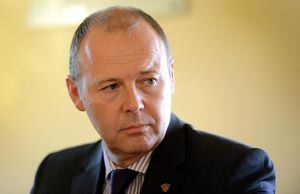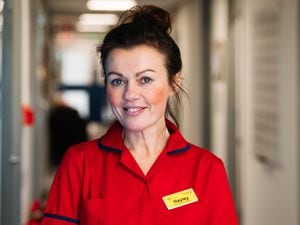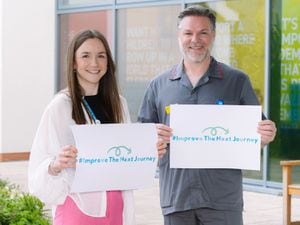Chief executive of trust Simon Wright outlines vision for future Shropshire's hospitals
Simon Wright, chief executive of Shropshire and Telford Hospitals NHS Trust, has set out his vision for the future of healthcare planning across the county.

Much has been said over the past few weeks about our hospital services.
It is natural, when there is talk of reconfiguring hospital services, for there to be a level of concern. But I believe it is really important to respond to any deliberately misleading comments and to those that obstruct attempts to provide a better service.
We need, collectively, to find a way through the differences of opinion and maintain a focus on what will give us the best results for patients.
To provide a better service, hospitals must not stand still; they must continually transform. For too long, our local NHS system has been caught in a gridlock that obstructed change. Staff at the hospitals – our doctors, nurses, other clinicians and support functions including management – were unable to progress their clinically-led ideas for improving patient care. Over time, this has led to a number of services becoming over-stretched.
Now we are tackling those issues head-on.
The NHS employs one in 20 workers in the UK. SaTH is made up of more than 5,500 people.
These people – our brothers, sisters, sons, daughters, friends, neighbours – these are the ones whose dedication, kindness and care are saving and renewing the NHS.
They have delivered amazing outcomes with kind and compassionate care these past 12 months in the face of the most challenging winter in decades.
A small population does not produce enough patients to keep a particular specialist up-to-date. A reasonable sized hospital trust needs to serve about half a million people if it is to have the right breadth of specialist cover and to keep a good proportion of specialist services local.
For this reason, the people of Shropshire, Telford & Wrekin and Mid Wales all need each other if they are to have a hospital trust in their geographic area.
Nonetheless, as we said over 18 months ago, it does make sense to keep two hospitals in the two major towns. The task is, therefore, to make one organisation work across two sites, in a way that reduces unnecessary duplication and encourages strength in depth. The answer is to have different centres of excellence on each site.
The centres of excellence approach should save us from slowly leaking services out of our county. If we get it right we may ensure services such as neurology, radiotherapy and vascular do not begin the next avalanche of services sucked into the larger cities.
While we wait for consultation on how this model might work, SaTH has continued to work hard to improve the existing approach. In the last 12 months we have recruited more than 180 additional permanent clinical staff and spent substantial sums on temporary staff to meet growth in patient demand.
We have invested over £500,000 in the A&E department at the Princess Royal Hospital and in a range of state-of-the-art equipment. We are committed to providing the best healthcare possible for all of the people we serve.
We are waiting for consultation on the new approach through the NHS Future Fit programme. This is part of the process to ensure the suggested clinical model is tested from all sides, particularly from the public’s point of view.
Our preferred clinical option is for a Planned Care Site at the Princess Royal Hospital in Telford (PRH), with the Emergency Centre at the Royal Shrewsbury Hospital (RSH).
Both hospitals would have a new Accident and Urgent Care Centre, which would manage medical illness and minor injuries, paediatrics and other ailments. This represents the majority of cases we see in our current A&Es today.
These centres would be supported by extended nurse practitioners, GPs and telemedicine support from our Emergency Centre doctors 24/7. Separating planned from unplanned care should mean a huge reduction in cancelled operations, better control of infection, and a better opportunity for specialists to offer the right care at the right time when people need it most. PRH would have 350 beds, centres of excellence in diabetes, bariatric surgery, imaging and diagnostics and elective surgery. Education and learning would be focused through a new Leadership Academy and Transforming Care Institute. Local outpatients would remain, as would fracture clinics.
We would keep a Women and Children’s Centre at PRH with breast services centralising there. Seven out of 10 women’s and children’s episodes of care would still be delivered locally, with specialist emergency paediatric care taking advantage of the greater depth of expertise at the Emergency Centre in RSH. Almost all outpatient antenatal and postnatal care would still be provided at Princess Royal Hospital or through midwifery-led services delivered at home or in the community. We would build a new cancer unit at PRH to deliver chemotherapy and holistic treatments, counselling and support.
We already see ambulance patients travelling out of county and to stop this from increasing we must create an Emergency Centre to provide the safest care for our most unwell people.
While our hospitals would both change, they would emerge safer and stronger. Our people would get the facilities they deserve to deliver the safest and kindest care possible to all of our families. The hospitals are not political footballs. We need them more now than at any time we can remember.
We need to see the NHS Future Fit programme move to public consultation this summer. We need our staff and patients’ voices to be heard. We need to move forward. Please don’t let this slip through our fingers – we need your help to make this a reality. Stand together with our staff and help us to build a better future for everyone.





